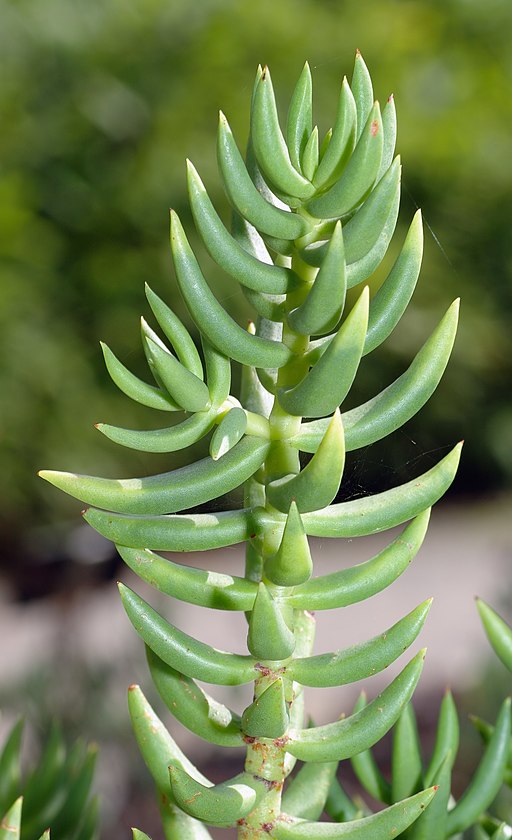Classification System: APG IV
Superregnum: Eukaryota
Regnum: Plantae
Cladus: Angiosperms
Cladus: Eudicots
Cladus: Core eudicots
Ordo: Saxifragales
Familia: Crassulaceae
Subfamilia: Crassuloideae
Genus: Crassula
Subgenus: C. subg. Disporocarpa
Sectio: C. sect. Acutifolia
Species: Crassula tetragona
Subspecies: C. t. subsp. acutifolia – C. t. subsp. connivens – C. t. subsp. lignescens – C. t. subsp. robusta – C. t. subsp. rudis – C. t. subsp. tetragona
Name
Crassula tetragona L., Sp. Pl. 283 1753.
References
Linnaeus, C. 1753. Species plantarum, exhibentes plantas rite cognitas, ad genera relatas, cum differentiis specificis, nominibus trivialibus, synonymis selectis, locis natalibus, secundum systema sexuale digestas. Tomus I. Pp. [I–XII], 1–560. Impensis Laurentii Salvii, Holmiae [Stockholm]. BHL Reference page. : 283.
Links
Hassler, M. 2019. Crassula tetragona. World Plants: Synonymic Checklists of the Vascular Plants of the World In: Roskovh, Y., Abucay, L., Orrell, T., Nicolson, D., Bailly, N., Kirk, P., Bourgoin, T., DeWalt, R.E., Decock, W., De Wever, A., Nieukerken, E. van, Zarucchi, J. & Penev, L., eds. 2019. Species 2000 & ITIS Catalogue of Life. Published online. Accessed: 2019 November 25. Reference page.
Govaerts, R. et al. 2019. Crassula tetragona in Kew Science Plants of the World online. The Board of Trustees of the Royal Botanic Gardens, Kew. Published online. Accessed: 2019 November 25. Reference page.
International Plant Names Index. 2019. Crassula tetragona. Published online. Accessed: November 25 2019.
Tropicos.org 2019. Crassula tetragona. Missouri Botanical Garden. Published online. Accessed: 25 November 2019.
USDA, ARS, Germplasm Resources Information Network. Crassula tetragona in the Germplasm Resources Information Network (GRIN), U.S. Department of Agriculture Agricultural Research Service. Accessed: 07-Oct-06.
Vernacular names
Afrikaans: Karkai
suomi: Ristipaunikko
Crassula tetragona is a succulent plant native to Southern Africa. It is widely distributed from the Orange River boundary of Namaqualand to beyond the Kei River in the Eastern Cape. "Tetragona" comes from the phyllotaxy of the leaves. It is popularly named the "miniature pine tree" among ornamental plant enthusiasts, for its popular use as a "pine tree" in Bonsai.
Description
The decumbent stems of Crassula tetragona subsp. acutifolia
The plant is erect or spreads shrubless to 1 m (3 ft). It has woody stems with brown bark, with crossed pairs of leaves. Leaves are green to dark green in color. The plant features terminal inflorescence ending in white flowers that come up in summer. The chromosome number varies: 2n=16, 32, 48. The subspecies are separated geographically, generally with only one subspecies per geographic area.
Taxonomy
The species was first described by Linnaeus in 1753 in his book Species Plantarum[1] There are six recognized subspecies, originally named by Tolken,[2] as follows:
C. tetragona subsp. acutifolia, stems decumbent, rooting at internodes, and sharply acute leaf apices.
C. tetragona subsp. tetragona, plant with multiple erect branches, and densely flowered inflorescence.
C. tetragona subsp. rudis, plant with a single main erect branch, but loosely branched inflorescence.
C. tetragona subsp. connivens, young stems are papillose, rounded flower thyrse
C. tetragona subsp. lignescens, young stems are smooth, mature stems are woody, leaves relatively small. The most widespread subspecies.
C. tetragona subsp. robusta, young stems are smooth, stems all carnose, leaves are large and robust. The most commonly cultivated subspecies.
Usage
These plants are usually used as an ornamental, although they are believed to have been used as a medicinal plant by Thunberg, who wrote: "Crassula tetragona, somewhat of an stringent nature, boiled in milk, in the quantity of a handful, is used as a remedy for diarrhea."[3]
Growth patterns
The plant requires a reasonable amount of water; more water is needed if flower buds are present. Most species prefer full sun, although some sub-species could be sensitive to too much sun. The plant is resistant to frost, but temperatures above 40 °F (4 °C) (6C) are best. The plant may be propagated from leaves and cuttings. It does not suffer from pests, other than the occasional mealy bug.[4]
Inflorescence of Crassula tetragona subsp. robusta
Leaf detail of Crassula tetragona subsp. lignescens, the gracile subspecies most widespread in habitat
References
Linnaeus, C.F. 1753 Species Plantarum.
Toelken, H.R. (1975). "A Revision of the Genus Crassula in Southern Africa". South African Journal of Botany. 41.
" Crassula, a grower's guide, Gordon Rowley, 2003. ISBN 88-900511-1-6
Crassulas in cultivation, Vera Higgins, 1964, Blandford Press Ltd.
Retrieved from "http://en.wikipedia.org/"
All text is available under the terms of the GNU Free Documentation License


